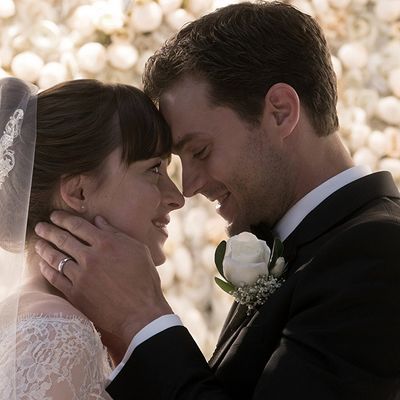
The Fifty Shades franchise is so many things to so many people. For some, it’s an exciting, sex-filled trilogy about a dominant and his submissive, and for others, it’s a soothing set of films where none of the leads ever speak above an ASMR-level whisper. Many go to these films to enjoy attractive naked people cavorting in expensive locations; others go in wondering, “How will Rita Ora be disrespected this time?” (At one point in this film, her character is abducted and held for $5 million, and I just wanted to tell her kidnapper, “Bro, she couldn’t even get that many retweets.”)
But are the Fifty Shades films basic? As I left the press screening for this week’s final installment, Fifty Shades Freed, I heard a critic dismiss the movie as such, implying that the film was so simple, so generic, that it might as well be an Olive Garden breadstick.
This, I push back on. Any critic who would describe the Fifty Shades films as basic or boring is not to be trusted: These films are insane, delightful, and borderline avant-garde in how they continually stymie every expectation of what a movie is supposed to do. There are elements thrown into the Fifty Shades franchise that would sustain a narrative through line in almost any other movie — a car chase here, a vengeful, gun-wielding ex there — but here, they are often dropped as soon as they’re introduced, with the films careening away from their own plot points like a pinball machine spring-loaded with Ben Wa balls. No five-minute section in Fifty Shades Freed has any relation to the five minutes before it; the film just starts over. It’s Memento, but with butt plugs.
If you see a ton of movies for a living, as I do, this head-spinning unpredictability is a good thing. Movies have become so locked into a three-act structure prescribed by screenwriting guru Syd Field that if you give me the first ten minutes of a film, I can usually tell you what will happen in the last ten minutes. Some might say that’s good storytelling; I say, “Give me a movie like Fifty Shades Darker, which opens with a montage of vaginal rose petals and unexpectedly climaxes with a heartfelt scene delivered in front of a Vin Diesel poster.”
Trilogies, in particular, are now so commonplace that a story arc spread over three films feels as familiar as the ascent and fall of a roller coaster, but as I watched Fifty Shades Freed, I had no idea if it would ever pay off things set up in the previous two movies, if it cared to, or even where we were in the narrative. Smothered in a Danny Elfman score that eternally crescendos like a telenovela about to cut to commercial break, I started to lose track of the nature of time itself: I could only mark ten-minute increments based on the fact that another sex scene was beginning, and when the movie ended — seemingly out of nowhere, with a line of dialogue that truly should be regarded an all-time classic — I howled, sat stunned in my seat for a full 30 seconds, then rose to my feet to give the entire franchise a standing ovation.
I’ve watched pundits applaud Christopher Nolan for the twisty way he employs time-shifting narratives in Dunkirk, but that has nothing on Fifty Shades Freed, where the movie shows us Dakota Johnson opening a butt-play drawer at Jamie Dornan’s insistence, suddenly cuts to her sitting down at work the next day, then flashes back to a scene of missionary sex that challenges the viewer to ask him or herself: “Wait, does she have that snow globe in her ass right now?”
We’ve spent awards season touting Phantom Thread, where two strong-minded people tussle for control over their marriage, and I’ll have you know that Fifty Shades Freed is almost hilariously similar to that film in its themes, except that it has a Tyler Hoechlin cameo and a scene where Dornan debates shoving a spoonful of Halo Top straight into someone’s Rita Ora-fice. The names in Fifty Shades are just as delicious as Phantom Thread’s “Reynolds Woodcock,” and pronounced so skeptically — “Boyce … Fox?” “Mrs. … Anastasia … Grey?” — that it’s like everyone got new identities in witness protection and they’re already fucking it up. It’s wonderful!
So while other critics are ready to be done with this franchise, and the cast will now go their separate ways — Dakota Johnson has Luca Guadagnino’s next film lined up, while the rest of the actors will simply mark time until they are cast as the hot parents on a CW show — I have to confess, I’ll miss Fifty Shades and all that it has given us. This trilogy kept me on my toes until the very end, and offered more joy and entertainment than most actual “good” movies do. It may be embarrassing to say this in a public forum, but if it’s basic to love a franchise where Jamie Dornan does sexy pommel-horse exercises and occasionally smiles like a 10-year-old who just started a fire … if it’s basic to scream with laughter when Dakota Johnson tells an Ivanka look-alike, “You can go and climb into your shit-colored car and drive back to Seattle,” possibly the meanest line I’ve ever heard … if it’s basic to download a different streaming-music app just so Fifty Shades artists Ellie Goulding and Corinne Bailey Rae don’t dominate my carefully curated year-end Spotify list … well, hand me that pumpkin-spice latte and make LaurenConrad.com my home page, because I’m fifty shades of fucked up, and I’m loving it.

